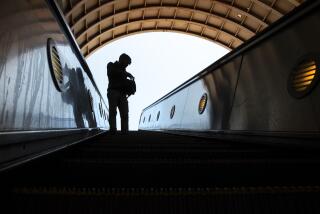Op-Ed: Full-body searches shouldn’t be the price to ride Metro
Electronic full-body scanners have become a fact of life at airports. But do we really need them everywhere?
In response to the recent announcement by the Metro rail system in Los Angeles that it plans to deploy mobile versions of the scanners — which can perform body searches from as much as 30 feet away — the American Civil Liberties Union Foundation of Southern California this week filed public-records requests to learn the exact details of the plan.
Metro will be the first public transit system in the U.S. to use these scanners, at a cost of $100,000 apiece. The rationale, according to the Metropolitan Transportation Authority, is safety: The machines are meant to detect suicide vests, explosives and large concealed weapons that can result in a “mass casualty attack.”
Yet the likelihood of such an attack is exceedingly slim. Americans are three times more likely to die by choking on their own food than in a mass shooting, and six times more likely to die in a shark attack than one perpetrated by a foreign-born terrorist.
Americans are three times more likely to die by choking on their own food than in a mass shooting.
In a blog post on its website, Metro doesn’t indicate how many of the scanners have been purchased, except to say “several” with plans to buy more. Nor do we know the technical details of the machines or exactly when and how they will be deployed.
Metro claims the machines can each scan about 2,000 people an hour as they walk past. The scanners don’t show anatomical details or emit radiation; they detect metallic and non-metallic objects that obscure the natural radio waves emitted by the human body. They also don’t show a distinct outline of the object — just the fact that something is there.
These few details add up to a disturbing reality: Metro’s scanners will force rail riders to forfeit their physical privacy in exchange for an indeterminate amount of protection against a statistically unlikely threat. The scanners risk turning us into suspects simply because of what we wear or put in our pockets. Plenty of innocuous objects carried under a coat or hoodie could register as suspect by the scanners, including purses, packages, musical instruments or even a body-worn medical device.
The invasion of privacy could also last long beyond a quick scan. Nothing prevents Metro officials from storing the captured digital information in a database, tagging it by date, time and location, or feeding it into a larger network of surveillance technologies. Tests of the devices performed for journalists revealed that they are also capable of capturing clear images of individuals’ faces, which can easily be stored and fed through widely available facial recognition software sold by the likes of Amazon.
When a scanner registers a “hit,” officers will have to decide whether or not to stop the person for further questioning. That’s a judgment call that inevitably invites the possibility of racially motivated stops. Research shows that police detain, question, and use force against black and brown people at rates far greater than their white counterparts, even in circumstances in which whites are more likely to have committed crimes.
The dragnet use of these scanners in public rail stations is particularly suspect. The Constitution prohibits the government from searching our bodies when it does not suspect us of committing a crime. Although judges have departed from this basic rule for airport searches on the assumption that flying is uniquely susceptible to mass casualty attacks, it’s hardly clear that it’s applicable to other public spaces.
Enter the Fray: First takes on the news of the minute from L.A. Times Opinion »
Union Station in downtown L.A., for example, is a treasured space where people gather to share meals, attend weddings, and shop at a weekly farmer’s market. It is always heavily populated — will that be reason enough to trigger regular scanning there? Metro says it will respect our constitutional rights by posting signs when it is using the scanners, but if we object to the intrusion, the price we will pay is to be turned away from the station and refused access to public transit.
According to Metro, one use of the scanners could be for large, issue-driven gatherings, such as the January 2017 women’s march. On that occasion, 360,000 more people than usual rode the Metro. The use of invasive security screenings could have quelled some protestors’ interest in attending the rally, potentially violating the 1st Amendment.
Given all of these concerns, at what point will we decide that the specter of terrorism no longer justifies massive public investment in invasive security technologies? Rather than accepting the “airportization” of our public transit system as inevitable or necessary, we should question the details and weigh the costs of Metro’s new body scanners.
Mohammad Tajsar is staff attorney at the ACLU Foundation of Southern California.
Follow the Opinion section on Twitter @latimesopinionand Facebook
More to Read
A cure for the common opinion
Get thought-provoking perspectives with our weekly newsletter.
You may occasionally receive promotional content from the Los Angeles Times.






